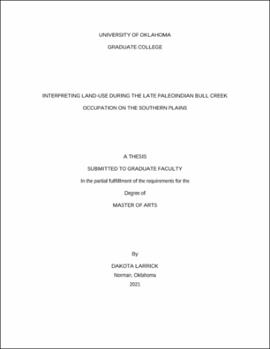| dc.contributor.advisor | Bement, Leland | |
| dc.contributor.author | Larrick, Dakota | |
| dc.date.accessioned | 2021-06-08T13:42:08Z | |
| dc.date.available | 2021-06-08T13:42:08Z | |
| dc.date.issued | 2021-05-14 | |
| dc.identifier.uri | https://hdl.handle.net/11244/330067 | |
| dc.description.abstract | The Bull Creek late Paleoindian archaeological site (34BV176), located along a tributary of the Beaver River in the Oklahoma Panhandle, is among the few known earliest human occupation sites on the Southern Plains. Located less than 2 kilometers (0.75 miles) away is the contemporaneous Ravenscroft site (34BV198), where investigations have revealed two arroyos containing the remains of at least five separate, large-scale bison hunting events. By applying catchment analysis to the faunal, lithic, and botanical data acquired through excavation at the sites and integrating those results with data on temporality, a land-use model applicable to late Paleoindian occupants of the Bull Creek valley is constructed. This preliminary model outlines their subsistence and settlement strategies and situates them within the surrounding landscape. Utilization of the landscape approach offers a comprehensive and humanizing way of interpreting the late Paleoindian archaeological record in the Bull Creek valley. | en_US |
| dc.language | en_US | en_US |
| dc.subject | Anthropology, Archaeology. | en_US |
| dc.subject | landscape archaeology | en_US |
| dc.subject | late paleoindian | en_US |
| dc.subject | land-use | en_US |
| dc.title | Interpreting Land-Use During the Late Paleoindian Bull Creek Occupation on the Southern Plains | en_US |
| dc.contributor.committeeMember | Pailes, Matthew | |
| dc.contributor.committeeMember | Pitblado, Bonnie | |
| dc.date.manuscript | 2021-05-05 | |
| dc.thesis.degree | Master of Arts | en_US |
| ou.group | College of Arts and Sciences::Department of Anthropology | en_US |
| shareok.orcid | https://orcid.org/0000-0002-0468-0299 | en_US |
| shareok.nativefileaccess | restricted | en_US |
